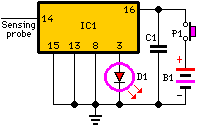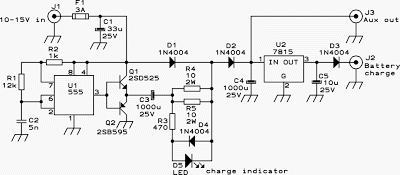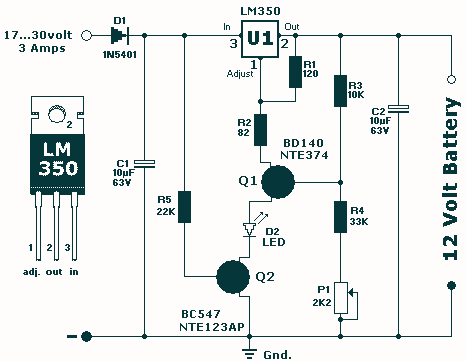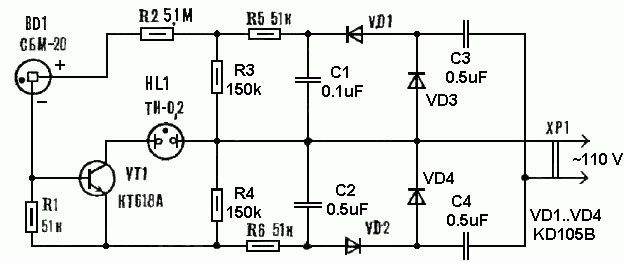
Isolated Fuse Fail Indicator

This circuit utilizes standard components to indicate the fuse status of mains-powered equipment while ensuring electrical isolation from the mains supply. A standard miniature low-power mains transformer (for example, with an output of approximately 6 V at 1.5 VA) serves as a sensing transformer, with its primary winding (230 V) connected across the equipment's input fuse. When the fuse blows, mains voltage is applied to the transformer, resulting in a 6 V AC output voltage at the secondary winding. A 1N4148 diode rectifies this voltage, causing an LED to illuminate, indicating that the fuse has failed. The rectified voltage is then connected to an RC low-pass filter composed of a 10 kΩ resistor and a 100 nF capacitor. The resulting positive signal can be utilized as an input to an A/D converter or as a digital input to a microcontroller, provided that the signal level complies with the microcontroller's input voltage specifications. A 1 MΩ resistor is employed to discharge the capacitor in cases where the input impedance of the connected equipment is very high. While the fuse remains intact, it shorts out the primary winding of the sensing transformer, resulting in a zero output at the secondary.
This circuit design effectively combines safety and functionality by utilizing a low-power transformer to detect fuse status without directly exposing sensitive components to mains voltage. The use of the 1N4148 diode for rectification is a common practice in low-voltage applications, ensuring that the LED indicator operates reliably when the fuse is blown. The RC low-pass filter serves the dual purpose of smoothing the rectified voltage and providing a stable signal for further processing.
The choice of a 10 kΩ resistor and a 100 nF capacitor in the RC filter is critical for achieving an appropriate time constant, which determines how quickly the circuit responds to changes in voltage. This configuration allows for a stable output signal that can be read by an A/D converter or a microcontroller, facilitating integration into more complex systems. The additional 1 MΩ resistor is a prudent design choice, ensuring that the capacitor can discharge adequately and preventing false readings in high-impedance scenarios.
Overall, this circuit is a practical solution for monitoring fuse status in mains-powered equipment, providing both visual indication and the capability for digital signal processing, while maintaining electrical isolation and safety standards.This circuit uses standard components and shows a method of indicating the fuse status of mains powered equipment while providing electrical isolation from the mains supply. A standard miniature low power mains transformer (e. g. with an output of around 6 V at 1. 5 VA) is used as a sense` transformer with its primary winding (230 V) connected acros s the equipment`s input fuse so that when the fuse blows, mains voltage is applied to the transformer and a 6 V ac output voltage appears at the secondary winding. The 1N4148 diode rectifies this voltage and the LED lights to indicate that the fuse has failed. The rectified voltage is now connected to an RC low-passlter formed by the 10 k resistor and 100 nF capacitor.
The resulting positive signal can now be used as an input to an A/D converter or as a digital input to a microcontroller (make sure that the signal level is within the microcontroller input voltage level specification). The 1 M resistor is used to discharge the capacitor if the input impedance of the connected equipment is very high.
As long as the fuse remains intact it will short out the primary winding of the sense` transformer so that its secondary output is zero. 🔗 External reference
This circuit design effectively combines safety and functionality by utilizing a low-power transformer to detect fuse status without directly exposing sensitive components to mains voltage. The use of the 1N4148 diode for rectification is a common practice in low-voltage applications, ensuring that the LED indicator operates reliably when the fuse is blown. The RC low-pass filter serves the dual purpose of smoothing the rectified voltage and providing a stable signal for further processing.
The choice of a 10 kΩ resistor and a 100 nF capacitor in the RC filter is critical for achieving an appropriate time constant, which determines how quickly the circuit responds to changes in voltage. This configuration allows for a stable output signal that can be read by an A/D converter or a microcontroller, facilitating integration into more complex systems. The additional 1 MΩ resistor is a prudent design choice, ensuring that the capacitor can discharge adequately and preventing false readings in high-impedance scenarios.
Overall, this circuit is a practical solution for monitoring fuse status in mains-powered equipment, providing both visual indication and the capability for digital signal processing, while maintaining electrical isolation and safety standards.This circuit uses standard components and shows a method of indicating the fuse status of mains powered equipment while providing electrical isolation from the mains supply. A standard miniature low power mains transformer (e. g. with an output of around 6 V at 1. 5 VA) is used as a sense` transformer with its primary winding (230 V) connected acros s the equipment`s input fuse so that when the fuse blows, mains voltage is applied to the transformer and a 6 V ac output voltage appears at the secondary winding. The 1N4148 diode rectifies this voltage and the LED lights to indicate that the fuse has failed. The rectified voltage is now connected to an RC low-passlter formed by the 10 k resistor and 100 nF capacitor.
The resulting positive signal can now be used as an input to an A/D converter or as a digital input to a microcontroller (make sure that the signal level is within the microcontroller input voltage level specification). The 1 M resistor is used to discharge the capacitor if the input impedance of the connected equipment is very high.
As long as the fuse remains intact it will short out the primary winding of the sense` transformer so that its secondary output is zero. 🔗 External reference





